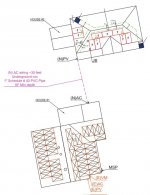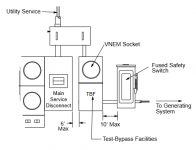brycenesbitt
Senior Member
- Location
- United States
In the case of a single PV system spread over two buildings, what's the
right thing for code or best practice, regarding grounding or bonding the upstream building?
Attached is a diagram.
--
The upstream building has nine panels on micro-inverters, with an AC disconnect on the side of the building, then plastic conduit to a combiner. The two systems join at the combiner. The interconnecting conduit is specified as plastic.
This system will never connect to the existing MSP (main service panel), instead get it's own backfeed meter.
--
My question is on code or best practice for grounding/bonding.
Should there be a ground rod at the AC disconnect on each building, or just a single ground rod at the combiner or MSP?
And would that AC disconnect ground rod if installed be better for lightning or for clearing electrical faults?

right thing for code or best practice, regarding grounding or bonding the upstream building?
Attached is a diagram.
--
The upstream building has nine panels on micro-inverters, with an AC disconnect on the side of the building, then plastic conduit to a combiner. The two systems join at the combiner. The interconnecting conduit is specified as plastic.
This system will never connect to the existing MSP (main service panel), instead get it's own backfeed meter.
--
My question is on code or best practice for grounding/bonding.
Should there be a ground rod at the AC disconnect on each building, or just a single ground rod at the combiner or MSP?
And would that AC disconnect ground rod if installed be better for lightning or for clearing electrical faults?




